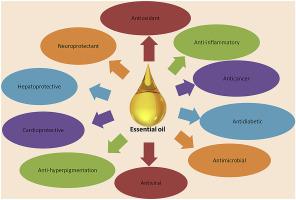Trends in Food Science & Technology ( IF 15.3 ) Pub Date : 2020-04-30 , DOI: 10.1016/j.tifs.2020.04.025 B. Sharmeen Jugreet , Shanoo Suroowan , R.R. Kannan Rengasamy , M. Fawzi Mahomoodally

|
Background
Essential oils (EOs) have remained in the limelight of the scientific community due their versatility coupled with consumers increasing demand for natural, safe and effective health products. Besides, their applications in the food, pharmaceutical, agricultural and textile industries amongst others have consolidated their popularity.
Scope and approach
EOs are rich sources of pharmacologically active phytoconstituents which justifies their health and industrial applications. Despite their wide applications, their low aqueous solubility, high volatility and sensitivity to light, temperature and oxygen compromise the exploration of their abounding benefits. Hence, this paper focuses on disseminating the chemistry, pharmacology, modes of action as well as the applications of EOs in various industries. Additionally, it focuses on the factors affecting their yield and composition as well as novel methods (micro-/nano-technology) that can be employed to optimize or potentiate their effects.
Key findings and conclusions: The pharmacological properties (anti: microbial; oxidant; hyperpigmentation; diabetic; viral; and cancer properties as well as the cardio-, hepato- and neuro-protective effects) of EOs have been validated through various studies and their corresponding mechanisms of action have been reported in this paper. Notably, their antimicrobial and antioxidant attributes have enabled their exploration in active packagings whereby they extend the shelf-life alongside maintaining food quality. On the other hand, their encapsulation in nanodelivery sytems allows to target and modulate their release, thereby enhancing their pharmacological potentials for biomedical applications. In addition to imparting fragrance, they serve as antimicrobials in fabrics in textile industry, while their biocidal effects makes them effective eco-friendly pesticides for agricultural uses.
中文翻译:

精油的化学,生物活性,作用方式和工业应用
背景
精油(EOs)的多功能性以及消费者对天然,安全和有效的保健产品的需求不断增加,一直是科学界关注的焦点。此外,它们在食品,制药,农业和纺织工业中的应用巩固了它们的知名度。
范围和方法
EOs具有丰富的药理活性植物成分,可证明其健康和工业应用价值。尽管具有广泛的用途,但它们的低水溶性,高挥发性以及对光,温度和氧气的敏感性损害了对其丰富益处的探索。因此,本文着重于传播化学,药理学,作用方式以及EO在各种行业中的应用。此外,它着重于影响其产量和组成的因素以及可以用来优化或增强其效果的新方法(微/纳米技术)。
主要发现和结论:EO的药理特性(抗:微生物;氧化剂;色素沉着;糖尿病;病毒;和癌症的特性以及对心脏,肝脏和神经的保护作用)已通过各种研究得到验证,并且它们的相应作用机理已经被证实。本文报道。值得注意的是,它们的抗微生物和抗氧化剂特性使他们能够在活性包装中进行探索,从而在延长保质期的同时保持食品质量。另一方面,它们包封在纳米递送系统中可以靶向并调节其释放,从而增强其在生物医学应用中的药理潜力。除了赋予香味外,它们还可以在纺织工业的织物中用作抗菌剂,


























 京公网安备 11010802027423号
京公网安备 11010802027423号